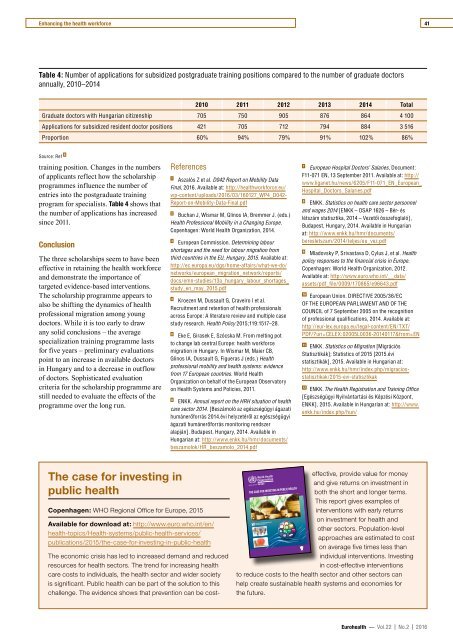EUROHEALTH
Eurohealth-volume22-number2-2016
Eurohealth-volume22-number2-2016
You also want an ePaper? Increase the reach of your titles
YUMPU automatically turns print PDFs into web optimized ePapers that Google loves.
1<br />
Enhancing the health workforce<br />
41<br />
Table 4: Number of applications for subsidized postgraduate training positions compared to the number of graduate doctors<br />
annually, 2010 – 2014<br />
2010 2011 2012 2013 2014 Total<br />
Graduate doctors with Hungarian citizenship 705 750 905 876 864 4 100<br />
Applications for subsidized resident doctor positions 421 705 712 794 884 3 516<br />
Proportion 60% 94% 79% 91% 102% 86%<br />
Source: Ref 6<br />
training position. Changes in the numbers<br />
of applicants reflect how the scholarship<br />
programmes influence the number of<br />
entries into the postgraduate training<br />
program for specialists. Table 4 shows that<br />
the number of applications has increased<br />
since 2011.<br />
Conclusion<br />
The three scholarships seem to have been<br />
effective in retaining the health workforce<br />
and demonstrate the importance of<br />
targeted evidence-based interventions.<br />
The scholarship programme appears to<br />
also be shifting the dynamics of health<br />
professional migration among young<br />
doctors. While it is too early to draw<br />
any solid conclusions – the average<br />
specialization training programme lasts<br />
for five years – preliminary evaluations<br />
point to an increase in available doctors<br />
in Hungary and to a decrease in outflow<br />
of doctors. Sophisticated evaluation<br />
criteria for the scholarship programme are<br />
still needed to evaluate the effects of the<br />
programme over the long run.<br />
References<br />
1<br />
Aszalós Z et al. D042 Report on Mobility Data<br />
Final, 2016. Available at: http://healthworkforce.eu/<br />
wp-content/uploads/2016/03/160127_WP4_D042-<br />
Report-on-Mobility-Data-Final.pdf<br />
2<br />
Buchan J, Wismar M, Glinos IA, Bremmer J. (eds.)<br />
Health Professional Mobility in a Changing Europe.<br />
Copenhagen: World Health Organization, 2014.<br />
3<br />
European Commission. Determining labour<br />
shortages and the need for labour migration from<br />
third countries in the EU, Hungary, 2015. Available at:<br />
http://ec.europa.eu/dgs/home-affairs/what-we-do/<br />
networks/european_migration_network/reports/<br />
docs/emn-studies/13a_hungary_labour_shortages_<br />
study_en_may_2015.pdf<br />
4<br />
Kroezen M, Dussault G, Craveiro I et al.<br />
Recruitment and retention of health professionals<br />
across Europe: A literature review and multiple case<br />
study research. Health Policy 2015;119:1517–28.<br />
5<br />
Eke E, Girasek E, Szócska M. From melting pot<br />
to change lab central Europe: health workforce<br />
migration in Hungary. In Wismar M, Maier CB,<br />
Glinos IA, Dussault G, Figueras J (eds.) Health<br />
professional mobility and health systems: evidence<br />
from 17 European countries. World Health<br />
Organization on behalf of the European Observatory<br />
on Health Systems and Policies, 2011.<br />
6<br />
ENKK. Annual report on the HRH situation of health<br />
care sector 2014. [Beszámoló az egészségügyi ágazati<br />
humánerőforrás 2014.évi helyzetéről az egészségügyi<br />
ágazati humánerőforrás monitoring rendszer<br />
alapján]. Budapest, Hungary, 2014. Available in<br />
Hungarian at: http://www.enkk.hu/hmr/documents/<br />
beszamolok/HR_beszamolo_2014.pdf<br />
7<br />
European Hospital Doctors’ Salaries, Document:<br />
F11-071 EN, 13 September 2011. Available at: http://<br />
www.liganet.hu/news/6205/F11-071_EN_European_<br />
Hospital_Doctors_Salaries.pdf<br />
8<br />
ENKK. Statistics on health care sector personnel<br />
and wages 2014 [ENKK – OSAP 1626 – Bér- és<br />
létszám statisztika, 2014 – Vezetői összefoglaló],<br />
Budapest, Hungary, 2014. Available in Hungarian<br />
at: http://www.enkk.hu/hmr/documents/<br />
beresletszam/2014/teljes/eu_vez.pdf<br />
9<br />
Mladovsky P, Srivastava D, Cylus J, et al. Health<br />
policy responses to the financial crisis in Europe.<br />
Copenhagen: World Health Organization, 2012.<br />
Available at: http://www.euro.who.int/__data/<br />
assets/pdf_file/0009/170865/e96643.pdf<br />
10<br />
European Union. DIRECTIVE 2005/36/EC<br />
OF THE EUROPEAN PARLIAMENT AND OF THE<br />
COUNCIL of 7 September 2005 on the recognition<br />
of professional qualifications, 2014. Available at:<br />
http://eur-lex.europa.eu/legal-content/EN/TXT/<br />
PDF/?uri=CELEX:02005L0036-20140117&from=EN<br />
11<br />
ENKK. Statistics on Migration [Migrációs<br />
Statisztikák]; Statistics of 2015 [2015.évi<br />
statisztikák], 2015. Available in Hungarian at:<br />
http://www.enkk.hu/hmr/index.php/migraciosstatisztikak/2015-evi-statisztikak<br />
12<br />
ENKK. The Health Registration and Training Office<br />
[Egészségügyi Nyilvántartási és Képzési Központ,<br />
ENKK], 2015. Available in Hungarian at: http://www.<br />
enkk.hu/index.php/hun/<br />
The case for investing in<br />
public health<br />
Copenhagen: WHO Regional Office for Europe, 2015<br />
Available for download at: http://www.euro.who.int/en/<br />
health-topics/Health-systems/public-health-services/<br />
publications/2015/the-case-for-investing-in-public-health<br />
The economic crisis has led to increased demand and reduced<br />
resources for health sectors. The trend for increasing health<br />
care costs to individuals, the health sector and wider society<br />
is significant. Public health can be part of the solution to this<br />
challenge. The evidence shows that prevention can be costeffective,<br />
provide value for money<br />
and give returns on investment in<br />
both the short and longer terms.<br />
This report gives examples of<br />
interventions with early returns<br />
on investment for health and<br />
other sectors. Population-level<br />
approaches are estimated to cost<br />
on average five times less than<br />
individual interventions. Investing<br />
in cost-effective interventions<br />
to reduce costs to the health sector and other sectors can<br />
help create sustainable health systems and economies for<br />
the future.<br />
THE CASE FOR INVESTING IN PUBLIC HEALTH<br />
A public health summary report for EPHO 8<br />
Assuring sustainable organizational<br />
structures and financing<br />
The case for investing in public health<br />
Eurohealth — Vol.22 | No.2 | 2016
















